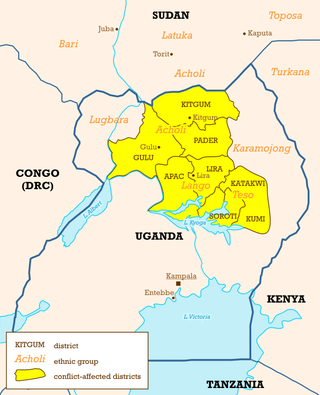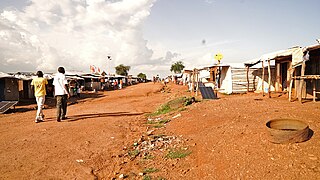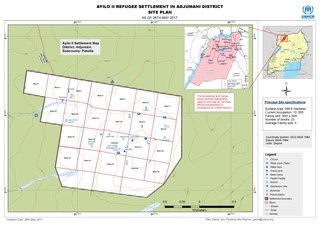
A refugee camp is a temporary settlement built to receive refugees and people in refugee-like situations. Refugee camps usually accommodate displaced people who have fled their home country, but camps are also made for internally displaced people. Usually, refugees seek asylum after they have escaped war in their home countries, but some camps also house environmental and economic migrants. Camps with over a hundred thousand people are common, but as of 2012, the average-sized camp housed around 11,400. They are usually built and run by a government, the United Nations, international organizations, or non-governmental organization. Unofficial refugee camps, such as Idomeni in Greece or the Calais jungle in France, are where refugees are largely left without the support of governments or international organizations.

Adjumani District is a district in Northern Uganda. Like most other Ugandan districts, it is named after its 'chief town', Adjumani, where the district headquarters are located.

Gulu is a city in the Northern Region of Uganda. It is the commercial and administrative centre of Gulu District.

Dungu is a town in Haut-Uele Province located at the confluence of the Dungu and Kibali Rivers where they join to form the Uele River, south of the Garamba National Park. Dungu's terrain is wooded savannah, and its climate is tropical.

The 2008 Christmas massacres took place on 24–27 December 2008, when the Lord's Resistance Army (LRA), a Ugandan rebel group, attacked several villages in Haut-Uele District, Democratic Republic of the Congo. The massacres were the fifth deadliest acts of terrorism in world history.
Sudanese refugees are persons originating from the country of Sudan, but seeking refuge outside the borders of their native country. In recent history, Sudan has been the stage for prolonged conflicts and civil wars, as well as environmental changes, namely desertification. These forces have resulted not only in violence and famine but also the forced migration of large numbers of the Sudanese population, both inside and outside the country's borders. Given the expansive geographic territory of Sudan, and the regional and ethnic tensions and conflicts, much of the forced migration in Sudan has been internal. Yet, these populations are not immune to similar issues that typically accompany refugeedom, including economic hardship and providing themselves and their families with sustenance and basic needs. With the creation of a South Sudanese state, questions surrounding southern Sudanese IDPs may become questions of South Sudanese refugees.
Kiryandongo Refugee Settlement is a refugee camp in Bweyale in Kiryandongo district Uganda.
South Sudanese refugees are persons originating from the African country of South Sudan, but seeking refuge outside the borders of their native country. The world's youngest independent country has a recent and troubled history of prolonged conflicts and ecosystem mismanagement such as overlogging, which has led to desertification. These forces have resulted not only in violence and famine, but also the forced migration of large numbers of the population, both inside and outside the country's borders. South Sudan was cited as the largest refugee crisis in 2016, being the world's third largest, followed by Syria and Afghanistan. As of 2022, the UNHCR estimated that there were 2.4 million refugees under its mandate originating from South Sudan, making the country the fifth largest source of refugees.

Rhino Camp Refugee Settlement is a refugee camp in the districts of Madi-Okollo and Terego in northwestern Uganda. It was opened in 1980 and expanded in the wake of the South Sudanese civil war to host the sudden influx of refugees into Northern Uganda. As of January 2018, the settlement had 123,243 registered refugees, mostly South Sudanese, and continues to receive new arrivals.
Pagirinya Refugee Settlement is a refugee camp in Eastern Adjumani District in Northern Uganda.

Bidibidi Refugee Settlement is a refugee camp in the Yumbe District of northwestern Uganda. Home to over 270,000 South Sudanese refugees fleeing the ongoing civil war in early 2017, it was among the largest refugee settlements in the world at the time, and may have been the largest. As of 2018, that distinction was claimed by Kutupalong refugee camp for displaced Rohingya in Bangladesh.
Nyumanzi Refugee Settlement is a refugee camp in Adjumani District in northwestern Uganda. Established in 2014, it hosts about 52,000 South Sudanese refugees.
The Palorinya Refugee Settlement is a refugee camp in the Moyo District of the Northern Region of Uganda. The majority of the population fled the civil crisis in South Sudan in 2016.
The Elema Refugee Settlement is a refugee settlement in Adjumani district, westnile sub-region of Uganda. Elema was established in 1992 and stands to be the oldest refugee settlement out of the total of nine settlement in Adjumani district. The settlement is composed entirely of refugees from the Kuku tribe of South Sudan. The Kuku speak a Bari dialect, also called Kuku. They are chiefly a farming people relying on mixed farming. Following a UNHCR-led repatriation of South Sudanese refugees in 2008 from Uganda, the Kuku ethnic group in Elema declined to be repatriated.

Alere 2 Refugee Settlement is located in Adjumani District in the Northern Region of Uganda.
Mungula II Refugee Settlement is a refugee camp found in Adjumani District Itirikwa subcounty in Northern Uganda.
Olua I Refugee settlement is a refugee camp in eastern Adjumani District in Northern Uganda. The Refugee settlement has its primary country as Uganda and other country south Sudan.
Oliji refugee settlement is a refugee camp in Adjumani District of Uganda.

Boroli refugee settlement is a refugee camp located in the Pakele Sub County of Adjumani District Northern Region, of Uganda.

Ayilo 2 refugee settlement is one of the refugee camps in Adjumani District in the Northern Region of Uganda.












